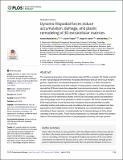Dynamic filopodial forces induce accumulation, damage, and plastic remodeling of 3D extracellular matrices
Author(s)
Malandrino, Andrea; Kamm, Roger D.
DownloadPublished version (3.483Mb)
Publisher with Creative Commons License
Publisher with Creative Commons License
Creative Commons Attribution
Terms of use
Metadata
Show full item recordAbstract
The mechanical properties of the extracellular matrix (ECM)–a complex, 3D, fibrillar scaffold of cells in physiological environments–modulate cell behavior and can drive tissue morphogenesis, regeneration, and disease progression. For simplicity, it is often convenient to assume these properties to be time-invariant. In living systems, however, cells dynamically remodel the ECM and create time-dependent local microenvironments. Here, we show how cell-generated contractile forces produce substantial irreversible changes to the density and architecture of physiologically relevant ECMs–collagen I and fibrin–in a matter of minutes. We measure the 3D deformation profiles of the ECM surrounding cancer and endothelial cells during stages when force generation is active or inactive. We further correlate these ECM measurements to both discrete fiber simulations that incorporate fiber crosslink unbinding kinetics and continuum-scale simulations that account for viscoplastic and damage features. Our findings further confirm that plasticity, as a mechanical law to capture remodeling in these networks, is fundamentally tied to material damage via force-driven unbinding of fiber crosslinks. These results characterize in a multiscale manner the dynamic nature of the mechanical environment of physiologically mimicking cell-in-gel systems.
Date issued
2019-04-08Department
Massachusetts Institute of Technology. Department of Mechanical Engineering; Massachusetts Institute of Technology. Department of Biological EngineeringJournal
PloS one
Publisher
Public Library of Science (PLoS)
Citation
Malandrino, Andrea er al. "Dynamic filopodial forces induce accumulation, damage, and plastic remodeling of 3D extracellular matrices." PloS one 15 (2019): e1006684 © 2019 The Author(s)
Version: Final published version
ISSN
1553-7358
Keywords
Ecology, Modelling and Simulation, Computational Theory and Mathematics, Genetics, Ecology, Evolution, Behavior and Systematics, Molecular Biology, Cellular and Molecular Neuroscience